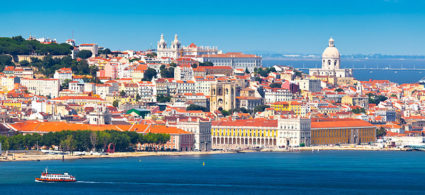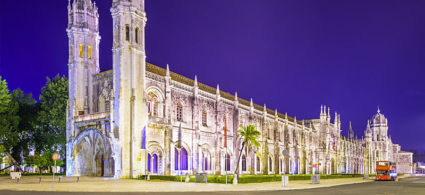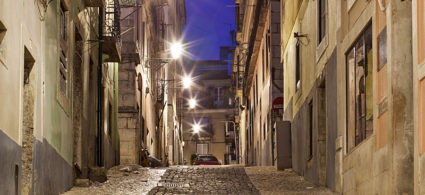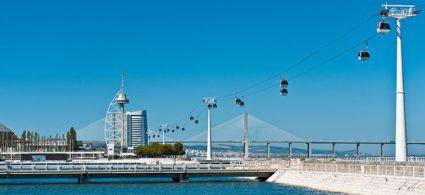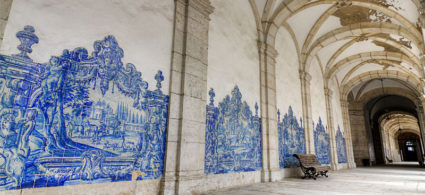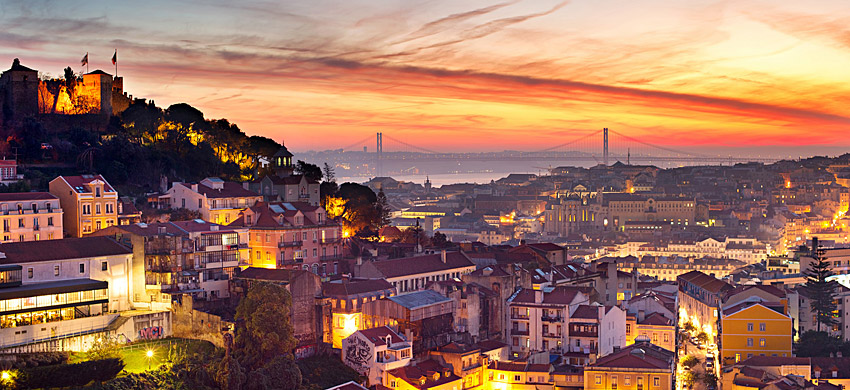

Lisbon is the westernmost capital of Europe, as well as the only capital facing the Atlantic Ocean. Its geographical position gives the city a spectacular light and a blue a clear sky.
The most characteristic view of the city is the one of its numerous alleys crossed by the typical yellow tram, one of the symbols of the city. The houses seem to be merged to one other and the breeze of the ocean carries into the air old stories of sailors and fishermen. It is not a coincidence if Vasco da Gama started his trip to the Indies from Lisbon.
Lisbon offers many things to do and see: in the common imaginary the city has always been associated to melancholy, the famous “saudade”; however, it is actually a very lively city offering plenty of things to see.

Located on the slope between Sao Jorge Castle and the Tagus river, Alfama is the oldest neighborhood of Lisbon and you can notice it by looking at the consumed facades of the houses, the faded azulejos, and the narrow alleys where the voices of people echo as if you were in a qasbah.
Alfama has actually been a qasbah during the Moorish domination; this area represented the whole city considering that the district of Baixa didn’t exist by that time. During the Arab domination, Alfama had its greatest development and was the home of nobles and merchants. The signs of that happy period remain visible in the details of the old noble moorish palaces and the numerous fountains hidden in the patios.
As other districts developed within the city, Alfama ended up being inhabited only by fishermen and port sailors working at the Tagus, on the slopes of the hill where the neighborhood itself is located. No more noble palaces nor aristocratic meetings but just the sound of alleys and narrow streets, as well as of stairs leading to miradouros, panoramic terraces overlooking the Tagus river and the many houses lined up on each other. The more you look at them, the more they seem to cling on each other.
In this twist of streets there is no room for modernity; no cars, no supermarkets, no fancy restaurants. Here there are just a few shops, groceries, and casas de fado, bars playing the traditional Portuguese music, which is very melancholy and reflects the real soul of Lisbon.
It is one of the neighbourhoods we recommend where to stay in Lisbon: for the most part, the accommodations in the Alfama are small independent flats, run by private individuals.
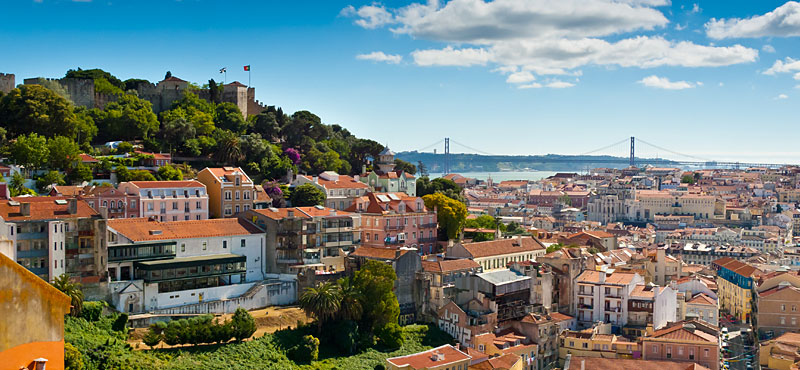
Sao Jorge Castle is one of the oldest buildings of the city as well as one of the most remarkable and visited attractions. Its potion, on the highest hill of Lisbon, offers a breathtaking view over the city and the estuary of the Tagus river. Do not miss a walk along the walls to enjoy a 360 degrees panoramic view.
Due to its privileged position, the castle has always played a key role in various wars: the fist fortified settlements date back to the VI century B.C.
The Castle was freed from the Moorish in 1147 by king Alfonso Henriques thanks to the help of the crusaders, during an episode known as the Siege of Lisbon. It later became the seat of the Royal Palace but it began to fall in decay during the XVI century, when the Palace was moved to the current Commerce Square.
Two strong earthquakes, one of 1531 and one of 1755, seriously damaged the structure. The recovery period started at the beginning of 1940s, and now Sao Jorge Castle is one of the main attractions of Lisbon. It is great for those who love strolling around parks and gardens and want to enjoy a stunning view of the city from above.

The largest square of Lisbon is located on the estuary of the Tagus river; the Ribeira Royal Palace was built here at the beginning of 1500, but then it was completely destroyed during the terrible earthquake of 1755.
After the earthquake, the Marquis of Pombal, the interior minister of those times, ordered the reconstruction of the square, giving back to it the right prestige within the city and integrating it into the luxurious Baixa district.
The name of the square was changed into Praca do Comercio in order to underline its new commercial position, as it became the place where merchants traded foreign products and financiers sent sailors on expeditions towards unknown worlds.
The magnificence of this square will conquer you straight away; the historical and commercial role that this square has played within the centuries is really tangible and you will feel it as soon as you get there. At the center of the square there is the statue of King José I designed in 1775 by the most famous Portuguese sculptor of that time. It was the first statue dedicated to a King in Lisbon.
The three sides of the square are defined by a traditional palace painted in yellow and interrupted by the Rua Augusta Arch, which is richly decorated and represents a real gateway into the center of the city. The Arch is embellished by a clock and statues representing the great characters of the Portuguese history, including the hero Viriato, Vasco da Gama, and the Marquis of Pombal, creator of the reconstruction.

Baixa is a district located between the Tagus river and Rossio, right at the center of the hills where the are the districts of Alfama and Bairro Alto. Starting from the Rua Arch, Baixa district merges into a twist of straight and parallel streets, having a precise geometrical order. This is how the Marquis of Pombal designed it during the reconstruction works that followed the earthquake of 1755. He built every single building according to anti-seismic principles.
Located in the heart of the city of Lisbon, this elegant district represents the center of the daily life of the capital city with its fashionable stores, restaurants, traditional pastry shops, and the numerous bars where to taste some local liquor.
Rua Augusta is the main pedestrian street, named after the Arch that arrives all the way to Rossio square, which represents another very important center of the city. In this area there are many banks and companies, turning Baixa into an important commercial and economic center.
One of the best attractions of the Baixa district is the Elevador de Santa Justa, a monument-elevator made in gothic style and featuring iron details. The elevator leads to the top of the tower, where you can enjoy a 360 degrees view on the city of Lisbon and its surrounding hills. Do not miss a visit to the Monastery do Carmo.

Walking along the narrow alleys of Alfama, you are likely to see squares and viewpoints that you would not expect but which represent one of the main characteristic of this district. One of the most beautiful one is the Miradouro de Santa Luzia, offering a stunning view of the Tagus river as well as of the red roofs of the Alfama district.
You can also see the typical arab walls of the city, the Dome of the Church of Saint Egracia, the Church of Santo Estevao, and the two white towers of the Church of San Miguel.
The main peculiarity of this terrace is its arched structure covered with plants and flowers, which are very colorful during spring and summer time. In addiction to the color of the flowers, there is the color of the typical Portuguese tiles, the azulejos, which cover and embellish the walls of the terrace.
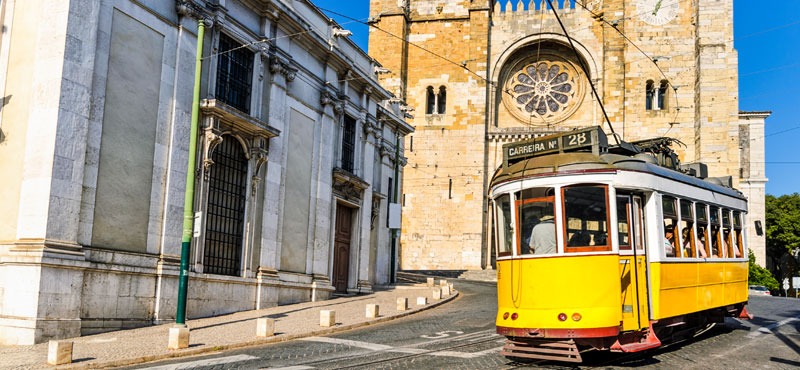
Lisbon Cathedral, called by the Portuguese Sé de Lisboa, is a church built in Roman Catholic style, as well as the seat of the Archidiocese of Lisbon. It was built in 1147 on the remains of the old mosque. Since then the building has been modified several times, and it has survived several earthquakes. The result is a mix of architectonical styles, even if the most predominant one is the Romanic style of its facade, with a rose window and two twin towers on the bell tower.
The interior of the cathedral had the classical Latin cross structure with three naves. In 1300 a cloister in Gothic style was added to the structure along with several chapels that got destroyed during the earthquake of 1755.
Also the tomb and the chapels of King Afonso IV and his family didn’t survive the earthquake; today we can only see the tombs of some noblemen and an ambulatory in pure Portuguese gothic style covered by ribbed vaulting and featuring a series of windows that bathe the interior with abundant light.
During the last century, many decorations in neoclassical style have been removed to give a more medieval look to the Cathedral. Inside the structure there are two organs – only one of them is still working – and some recent azulejos representing the visit of Pope John Paul II in 1982.

The complex of the Carmo Convent is made of a Romanic monastery and its church from 1398 which were both severely ruined during the earthquake of 1755. The church was intentionally not restructured and it represents one of the most tangible symbols of that massive catastrophe.
Its slightly disturbing appearance is balanced by the remains of the convent, which are almost dramatic with arches opened to the sky and the blue of the sky contrasting the light color of the stone. The stone wall collapsed in 1755 and it has never been rebuilt.
The Convent dominates Rossio square and overlooks the hill of Castle Sao Jorge. After the earthquake the complex was never fully recovered, and it has played different roles over the centuries. During the XIX century it was a base first for the Royal Guard and then for the army. Religious characters were expelled from the convent in 1835.
In 1864 the structure was under the control of the Association of Portuguese Archaeologists, that turned the ruined building into a museum, the Carmo Archaeological Museum, which exhibits pieces coming from different styles and places, dating back to various historical periods.

It stands out from the sea and it reaches towards the blue sky: its the Belém Tower, shining under the sun. It is one of the most representative monuments of Lisbon, as well as one of the most visited monuments by tourists. In 1983 it became a UNESCO World Heritage Site.
This 30 meters high bastion is boarded by four towers and it was commissioned by King John II as a defense system at the mouth of the Tagus river. Construction works began in 1515, but the king passed out and the tower was finally finished under the reign of his successor, King Manuel I. For this reason it is known for reflecting the so called “Manueline Style”, which merges gothic and bizantine elements.
Another fun fact regards its location, which has changed during the passing of the years. It was first built on the water, but now the tower is located at the shore of the river due to the movement of the shoreline and not to the earthquake of 1755, as people used to think in the past.

In the district of Belém, next to the Tago river, there is one of the most representative palaces of Manueline style, a majestic architecture from the period of transition between late gothic and romantic style, taking inspiration from King Manuel I: the Jeronimos monastery.
The Monastery replaced the formerly existing church of Ermida do Restelo, where Vasco da Gama and his men spent the night before leaving to the Indies.
King Manuel I wanted to build the monastery on that same site in order to celebrate the great sailors and the importance of the Kingdom of Portugal. The result is simply magnificent, combining and showcasing a blend of different yet recognisable styles. The monastery is home to the tombs of King Manuel and his family, the kings who succeeded him, as well as the tombs of Vasco da Gama and the poet Luis de Camoes. In the chapel there is the tomb of the writer Fernando Pessoa.
Along with the Belém Tower and the Monument to the Discoveries, the monastery celebrates one of the most important moments of the history of Portugal. The former monastery became a UNESCO World Heritage Site in 1983, together with the Belém Tower.
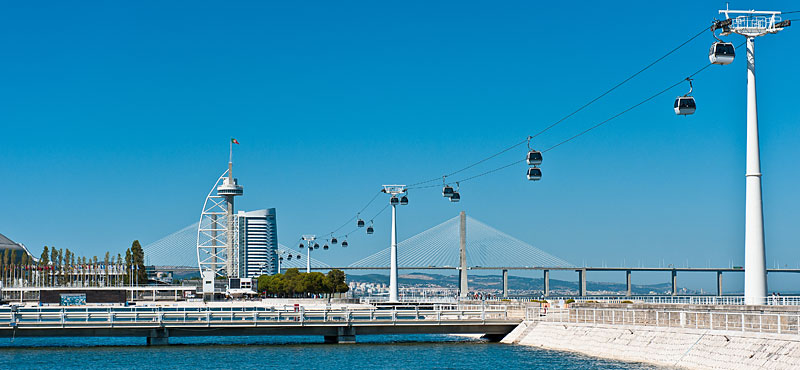
The old houses of Lisbon, its alleys and its historical monuments take visitors back in time, but it is also worth to mention that the city has also a very modern soul: the Park of Nations.
This district was built during Expo 1998, when the Spanish architect Santìago Calatrava was in charge of the reconvention and transformation of the empty pavilions and the industrial areas that could be used for recreational, cultural, commercial, and sporting purposes. From an aesthetical point of view it is a combination of steel structures, glass, and white painted concrete, to give birth to a very well designed urban architecture.
Soon the area has seen the opening of new malls, hotels, residential centers, a fair center, arenas for shows, a casino, and a harbor with a capacity of 600 boats. The renovation project has been a success and it is estimated that about 15.000 people live in the area, not to mention the number of people who use its services on a daily basis.
You should definitely visit the Oceanarium, an huge aquarium that has the shape of a floating boat as well as one of the biggest aquariums of Europe. There is also a cable car that was built during Expo in order to ensure a connecting service within a very vaste area. Now it connects the Oceanarium area to the hotel complex of the Vasco da Gama Tower; from there you can enjoy a stunning view above the whole neighborhood.
City Card allow you to save on public transport and / or on the entrances to the main tourist attractions.


